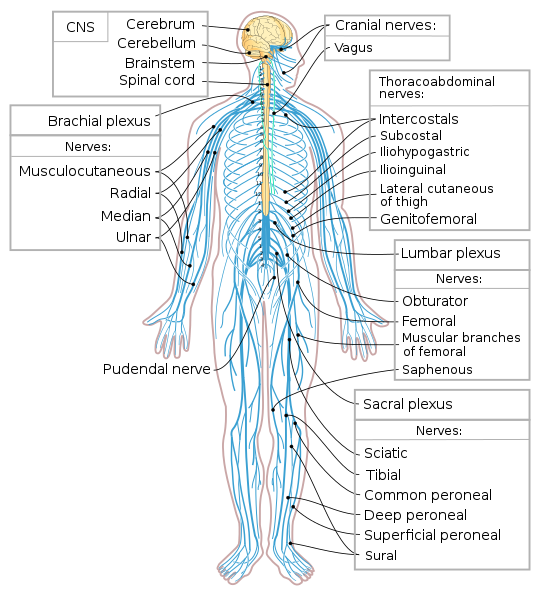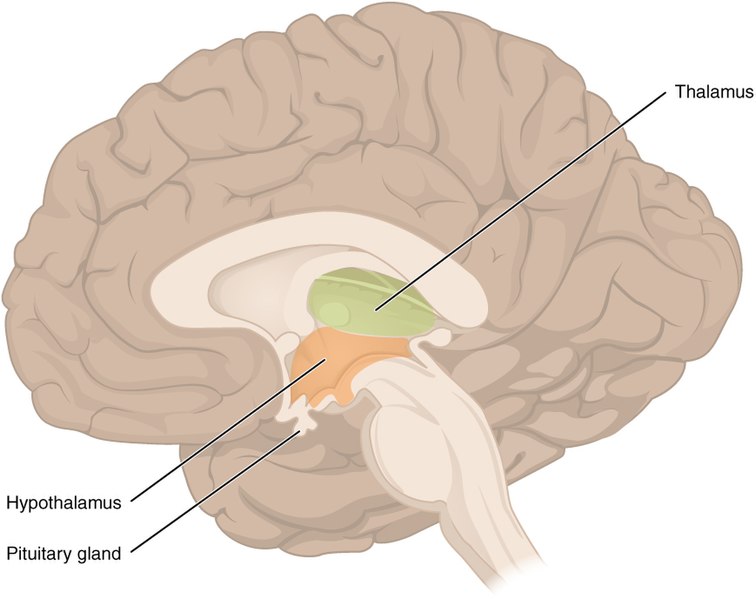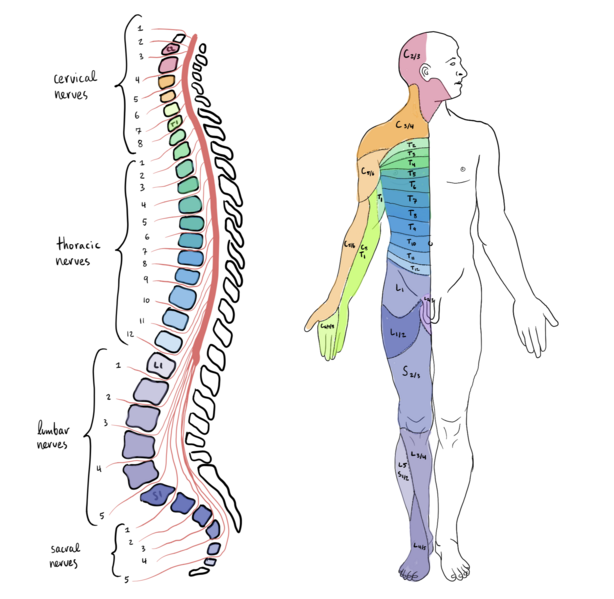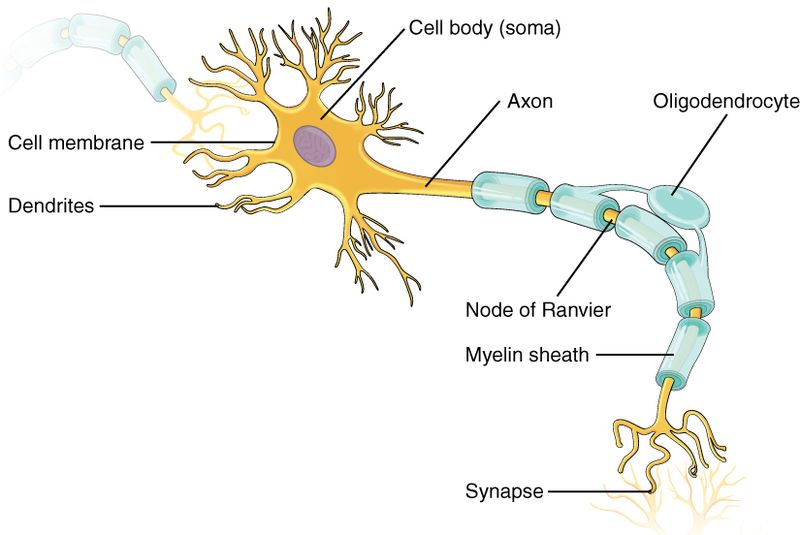9.2 Review of Anatomy & Physiology of the Nervous System
The nervous system is divided into two main parts called the central nervous system and the peripheral nervous system. See Figure 9.1[1] for an illustration of the nervous system.

The central nervous system (CNS) includes the brain and the spinal cord. The brain can be described as the interpretation center, and the spinal cord can be described as the transmission pathway.[2]
Brain
The major regions of the brain are the cerebrum, cerebral cortex, hypothalamus, thalamus, brain stem, and the cerebellum.
The largest portion of our brain is called the cerebrum. The cerebrum is covered by a wrinkled outer layer of gray matter called the cerebral cortex. The cerebral cortex is involved in complex brain functions, including memory, attention, perceptual awareness, thought, language, and consciousness. The cerebral cortex is divided into four lobes named the frontal, parietal, occipital, and temporal lobes. Each lobe has the following specific functions:
- Frontal Lobe: The frontal lobe is associated with movement. It contains neurons that instruct cells in the spinal cord to move skeletal muscles. The anterior portion of the frontal lobe is called the prefrontal lobe. The prefrontal lobe provides cognitive functions such as planning and problem-solving that contribute to our personality, short-term memory, and consciousness. Broca’s area is located in the frontal lobe and is responsible for the production of language and controlling movements responsible for speech.
- Parietal Lobe: The parietal lobe processes general sensations, including touch, pressure, tickle, pain, itch, and vibration.
- Temporal Lobe: The temporal lobe processes auditory information. Wernicke’s area is located in the temporal lobe and is responsible for the comprehension of written and spoken language. Because regions of the temporal lobe are part of the limbic system, memory is also an important function associated with the temporal lobe. The limbic system is involved with our behavioral and emotional responses needed for survival, such as feeding, reproduction, and the fight-or-flight responses.
- Occipital Lobe: The occipital lobe primarily processes visual information.
The cerebellum is the posterior part of the brain that controls fine motor skills. See Figure 9.2[3] for an illustration of the cerebellum and the lobes of the cerebral cortex.
![“Cerebrum lobes.svg” by Jkwchui is licensed under CC BY-SA 3.0[/footnote] Illustration showing Cerebellum and Lobes of the Cerebrum with text labels for major structures](https://wtcs.pressbooks.pub/app/uploads/sites/47/2024/03/Cerebrum_lobes.svg.png)
Deep within the cerebrum are the hypothalamus and the thalamus. The hypothalamus coordinates the autonomic nervous system and the activity of the pituitary, controlling body temperature, thirst, hunger, and other homeostatic systems. The thalamus is the relay center for sensory and motor signals to the cerebral cortex. See Figure 9.3[4] for an illustration of the hypothalamus and the thalamus.

The ventricles are a group of interconnected, fluid-filled cavities within the brain. The purpose of the ventricles is to produce cerebrospinal fluid to cushion and protect the brain.
Meninges are three membranes that protect the brain and spinal cord called the pia mater, arachnoid, and dura mater. The pia mater is the delicate inner layer. The arachnoid is the middle layer filled with fluid that cushions the brain. The dura mater is the tough outermost membrane enveloping the brain and spinal cord. The meningeal spaces are the spaces between the meningeal layers. There are three clinically significant meningeal spaces called the epidural, subdural, and subarachnoid.
The brain stem connects the spinal cord with the brain. It regulates several crucial autonomic functions in the body, including involuntary functions in the cardiovascular and respiratory systems and reflexes like vomiting, coughing, sneezing, and swallowing.
Spinal Cord
The spinal cord is a bundle of nerve fibers enclosed in the spine that connects nearly all parts of the body to the brain. It is a continuation of the brain stem that transmits sensory information to the brain and motor impulses to the muscles.
Peripheral Nervous System
The peripheral nervous system (PNS) consists of the remaining parts of the nervous system outside of the brain and spinal cord, including the cranial nerves that branch out from the brain and the spinal nerves that branch out from the spinal cord. The peripheral nervous system is the communication network between the brain and the body.[5]
Cranial Nerves
Cranial nerves are directly connected from the brain to the periphery. They are primarily responsible for the sensory and motor functions of the head and neck. There are twelve cranial nerves that are designated by Roman numerals I through XII. A popular mnemonic for memorizing the names of the cranial nerves is “Oh Once One Takes The Anatomy Final Some Good Vacations Are Heavenly,” in which the initial letter of each word corresponds to the initial letter in the name of each nerve. The cranial nerves include the following nerves[6]:
- O: The olfactory nerve is responsible for the sense of smell.
- O: The optic nerve is responsible for the sense of vision.
- O: The oculomotor nerve regulates eye movements by controlling four of the extraocular muscles, lifting the upper eyelid when the eyes point up and constricting the pupils.
- T: The trochlear nerve and the abducens nerve are both responsible for eye movement but do so by controlling different extraocular muscles.
- T: The trigeminal nerve regulates skin sensations of the face and controls the muscles used for chewing.
- A: The auditory/vestibulocochlear nerve manages hearing and balance.
- F: The facial nerve is responsible for the muscles involved in facial expressions, as well as part of the sense of taste and the production of saliva.
- S: The spinal (accessory) nerve controls movements of the neck, along with cervical spinal nerves.
- G: The glossopharyngeal nerve regulates the controlling muscles in the oral cavity and upper throat, as well as part of the sense of taste and the production of saliva.
- V: The vagus nerve is responsible for contributing to homeostatic control of the organs of the thoracic and upper abdominal cavities.
- A: The abducens nerve supplies the muscles involved with the lateral eye movement.
- H: The hypoglossal nerve manages the muscles of the lower throat and tongue.
Spinal Nerves
Spinal nerves are named based on the level of the spinal cord where they emerge. See Figure 9.4[7] for an illustration of spinal nerves. There are eight pairs of cervical nerves designated C1 to C8, twelve thoracic nerves designated T1 to T12, five pairs of lumbar nerves designated L1 to L5, five pairs of sacral nerves designated S1 to S5, and one pair of coccygeal nerves. All spinal nerves are sensory and motor nerves. Spinal nerves extend outward from the vertebral column to innervate the periphery while also transmitting sensory information back to the brain.

Each spinal nerve innervates a specific region of the body[8]:
- C1 provides motor innervation to muscles at the base of the skull.
- C2 and C3 provide both sensory and motor control to the back of the head and behind the ears.
- The phrenic nerve from C3, C4, and C5 innervates the diaphragm to enable breathing. This is vital because if a client has an injury where the spinal cord is cut above C3, then spontaneous breathing is not possible.
- C5 through C8 and T1 combine to form the brachial plexus, a tangled array of nerves that serve the upper limbs and upper back.
- The lumbar plexus arises from L1-L5 and innervates the pelvic region and the anterior legs.
- The sacral plexus comes from the lower lumbar nerves L4 and L5 and the sacral nerves S1 to S4. The sciatic nerve is a part of the sacral plexus. If the sciatic nerve becomes compressed due to degeneration of an intervertebral disc, a medical condition called sciatica occurs that causes pain in the back, hip, and outer side of the leg.
- S5 and the coccygeal nerves leave the sacral canal and provide partial innervation to several pelvic organs, including the uterus, fallopian tubes, bladder, and prostate.
If a client experiences a spinal cord injury, the degree of paralysis can be predicted by the location of the spinal cord injury. The higher up on the spinal cord an injury occurs, the greater loss of function. For example, a spinal cord injury higher on the spinal cord can cause paralysis in most of the body and affect all limbs (tetraplegia or quadriplegia). An injury that occurs lower on the spinal cord may only affect a person’s lower body and legs (paraplegia).
It is also important to remember when a client has a spinal cord injury and motor nerves are damaged, their sensory nerves may still be intact. If this occurs, the client can still feel sensation even if they can’t move the extremity.
Neurons
Nervous tissue in the CNS and PNS contains two basic types of cells: neurons and glial cells. Neurons are responsible for the communication that the nervous system provides. They are electrically active and release chemical signals called neurotransmitters. Glial cells play a supporting role for nervous tissue.[9]
Neurons provide electrical signals that communicate information about sensations and, in response, stimulate movements. The three-dimensional shape of neurons makes massive numbers of connections within the nervous system. The main part of a neuron is the cell body. A fiber that emerges from the cell body and projects to target cells is called the axon. A single axon can branch repeatedly to communicate with many target cells by sending nerve impulses. Dendrites conduct information received from other neurons at contact areas called a synapse. A synapse is a junction between two nerve cells, consisting of a tiny gap through which neurotransmitters pass. See Figure 9.5[10] for an illustration of a neuron.

Many axons are wrapped by an insulating substance called myelin, which is made from glial cells. The myelin sheath acts as insulation much like the plastic or rubber that is used to insulate electrical wires.
Neurotransmitters and Neuroreceptors
Electrical impulses from neurons signal the release of a neurotransmitter into a synapse. Neurotransmitters cause the impulse to be transferred to a neuroreceptor on another neuron, muscle fiber, or other structure. Neuroreceptors are specific for certain neurotransmitters, and the two fit together like a key and lock. See Figure 9.6[11] for an illustration of neuron communication.

Several nervous system diseases and mental health disorders are related to abnormal impulse transmission and/or imbalanced levels of neurotransmitters. See Table 9.1 for a list of major neurotransmitters. In this chapter, many of the alterations presented include a dysfunction in neurotransmission. It is helpful to understand the common neurotransmitters and their function to better understand neurological alterations. For example, dopamine is a neurotransmitter that influences movement and cognition. Dopamine imbalances are associated with Parkinson’s disease.[12],[13]
Table 9.1. Major Neurotransmitters
| Neurotransmitter | Source | Action | Example of Dysfunction |
|---|---|---|---|
| Acetylcholine (major transmitter of the parasympathetic nervous system) | Autonomic nervous system; includes numerous areas of the brain | Excitatory; parasympathetic effects but can be inhibitory such as stimulation of heart by the vagus nerve. | Decreased levels lead to myasthenia gravis. |
| Dopamine | Substantia nigra and basal ganglia | Typically inhibits and affects behavior such as attention, emotions, and fine movement. | Decreased levels lead to Parkinson’s disease. |
| Serotonin | Hypothalamus, brain stem, and dorsal horn of the spinal cord | Inhibitory effects and helps to control sleep and mood; inhibits pain pathways. | Decreased levels lead to depression. |
| Gamma-aminobutyric acid (GABA) | Spinal cord, basal ganglia, cerebellum, and some cortical areas | Inhibitory effect. | Decreased levels lead to seizures. |
| Norepinephrine (major transmitter of the sympathetic nervous system) | Brain stem, hypothalamus, and postganglionic neurons of the sympathetic nervous system | Typically excitatory; affects mood and overall activity levels. | Dysfunction is rarely seen. |
| Glutamate | Several types of receptors found through the CNS | Excitatory; its metabolism is important to maintaining optimal levels within the extracellular space. As such, it is important for memory, cognition, and mood regulation. | Dysfunction interferes with brain processing of information. Excess amounts can damage nerve cells. |
- “Nervous_system_diagram-en.svg” by Medium69, Jmarchn is licensed under CC BY-SA 4.0 ↵
- Betts, J. G., Young, K. A., Wise, J. A., Johnson, E., Poe, B., Kruse, D. H., Korol, O., Johnson, J. E., Womble, M., & DeSaix, P. (2022). Anatomy and Physiology 2e. OpenStax. https://openstax.org/books/anatomy-and-physiology-2e/pages/1-introduction ↵
- “Cerebrum lobes.svg” by Jkwchui is licensed under CC BY-SA 3.0 ↵
- “1310_Diencephalon.jpg” by OpenStax is licensed under CC BY 4.0 ↵
- Betts, J. G., Young, K. A., Wise, J. A., Johnson, E., Poe, B., Kruse, D. H., Korol, O., Johnson, J. E., Womble, M., & DeSaix, P. (2022). Anatomy and Physiology 2e. OpenStax. https://openstax.org/books/anatomy-and-physiology-2e/pages/1-introduction ↵
- Ernstmeyer, K., & Christman, E. (Eds.). (2023). Nursing skills 2e. Open RN. https://wtcs.pressbooks.pub/nursingskills/ ↵
- “Spinal_Cord_Segments_and_body_representation.png” by David Nascari and Alan Sved is licensed under CC BY-SA 4.0 ↵
- Betts, J. G., Young, K. A., Wise, J. A., Johnson, E., Poe, B., Kruse, D. H., Korol, O., Johnson, J. E., Womble, M., & DeSaix, P. (2022). Anatomy and Physiology 2e. OpenStax. https://openstax.org/books/anatomy-and-physiology-2e/pages/1-introduction ↵
- Betts, J. G., Young, K. A., Wise, J. A., Johnson, E., Poe, B., Kruse, D. H., Korol, O., Johnson, J. E., Womble, M., & DeSaix, P. (2022). Anatomy and Physiology 2e. OpenStax. https://openstax.org/books/anatomy-and-physiology-2e/pages/1-introduction ↵
- “1206_The_Neuron-1.jpg” by OpenStax is licensed under CC BY 4.0 ↵
- “Chemical synapse schema cropped.jpg” by Looie496 is licensed under Public Domain. ↵
- Ernstmeyer, K., & Christman, E. (Eds.). (2023). Nursing pharmacology - 2e. Open RN. https://wtcs.pressbooks.pub/pharmacology2e/ ↵
- Ernstmeyer, K., & Christman, E. (Eds.). (2023). Nursing skills 2e. Open RN. https://wtcs.pressbooks.pub/nursingskills/ ↵
Includes the brain and the spinal cord.
The posterior part of the brain that controls fine motor skills.
Area of the brain which serves as the body’s control center regulating temperature, heart rate, hunger, and mood.
The relay center for sensory and motor signals to the cerebral cortex.
Interconnected, fluid-filled cavities within the brain.
Three membranes that protect the brain and spinal cord called the pia mater, arachnoid, and dura mater.
Meninge that serves as the delicate inner layer.
The meninge middle layer filled with fluid that cushions the brain.
The tough outermost membrane enveloping the brain and spinal cord.
The space between the dura mater and vertebrae (spine).
A space between the dura and the arachnoid mater, containing a thin layer of serous fluid.
The space between the arachnoid membrane and the pia mater.
Connects the spinal cord with the brain.
The remaining parts of the nervous system outside of the brain and spinal cord, including the cranial nerves that branch out from the brain and the spinal nerves that branch out from the spinal cord.
Directly connected from the brain to the periphery.
Named based on the level of the spinal cord where they emerge.
Responsible for the communication that the nervous system provides.
Acts as insulation much like the plastic or rubber that is used to insulate electrical wires.
Cause an impulse to be transferred to a neuroreceptor on another neuron, muscle fiber, or other structure.
Receptors specific for certain neurotransmitters, and the two fit together like a key and lock.

